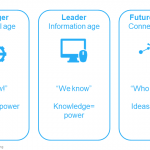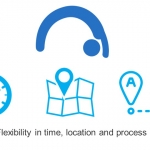 People worry that robots are taking the jobs of people. But more worrying is that too many people are still doing jobs better-designed for machines, and often our organisations and leadership is set up to manage robots, not people.
People worry that robots are taking the jobs of people. But more worrying is that too many people are still doing jobs better-designed for machines, and often our organisations and leadership is set up to manage robots, not people.
In our more industrial past, companies traditionally saw and used their workers as cogs in a machine. It was logical to make the machine slick and efficient, to maximise productivity and profitability. The management of the cogs was pretty mechanical too – usually command and control, top down with very little consideration for ‘hearts and minds’.
Now of course business and leaders have moved on, but often the legacy thinking still prevails in how organisations are set up and in some management behaviour and attitudes. In effect it’s cog-in-a-machine thinking best suited for robots.
And guess what? This gives the poor cogs a pretty rubbish experience; they can feel used and undervalued. They are hardly likely to be productive under these circumstances.
Interestingly, some manufacturing organisations, where robots have long replaced people on the assembly line, are ahead in their thinking and management. Nissan Motor Manufacturing UK (NMUK) at Sunderland recognise that machines can do a great deal of the tasks more effectively than people and like many manufacturing operations, their systems are heavily automated. The people, meanwhile, do what people do so much more brilliantly than machines – managing change, solving problems and being creative.
NMUK have systematised this principle with ‘Kaizen’ and job rotation. Kaizen is a Japanese word for continuous improvement. All workers are encouraged to constantly seek out improvements, no matter how small. Kaizen teams throughout the organisation investigate suggestions and get the good ones implemented. Job rotation at NMUK means that every person is trained to do three jobs, and each job can be done by three people. This means that staff absences don’t impede production, boredom is reduced and people are motivated by job variety.
Much office work is already being done better by machines.
Automated customer care company WDS (part of Xerox) estimate that in 2015 around 30% of office work could already be fully automated using existing technologies. This will only accelerate as big data, artificial intelligence and machine learning technologies become more common. Aspects of customer service tasks can already be automated, for example. Innovation in machine learning helps WDS clients make the customer care experience efficient, consistent, relevant and personal. The days are not far away when artificial intelligence will be commonly used to personalise customer service interactions.
What are the lessons for managers?
Well first of all, watch out for the remnants of cog-in-a-machine thinking and don’t manage people as if they were robots. Actually lead them. Encourage them to solve problems, look for improvements and innovate where they can. Say “thank you”.
And if your people are doing robot jobs now, part of your leadership should be to encourage and mentor them to learn new skills and acquire new, more relevant experience … because their jobs WILL go, sooner or later. Actually leading in the meantime will lead to far higher productivity and engagement, even if the job is pretty dull.
If you’d like to inspire and enable your leaders to better engage their teams by embracing the future of work, then call Simon on 020 3488 0464 or email simon@simonwalker.org








